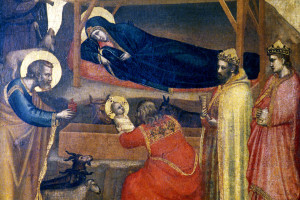WSJ Historically Speaking: The Glory Days of Frankincense and Myrrh
The Magi, the three wise men, famously offered the baby Jesus gifts of gold, frankincense and myrrh. We can still understand why they brought gold, but what Mary and Joseph were meant to do with the frankincense and myrrh—resins derived from the Boswellia and Commiphora trees—has become less obvious.
The usual explanation for the Magi’s gifts is that they symbolized the trajectory of Jesus’ life: gold to announce his divine origins and kingship, frankincense (which was burned in religious ceremonies) to declare his future role as a priest, and myrrh (which was used in burials) to represent his suffering and death.
But to the ancients, the significance of frankincense and myrrh went far beyond their spiritual symbolism. Both commodities had played a central role in daily life since the dawn of civilization. The resins were introduced to Egypt in the third millennium B.C. from the Land of Punt (thought to have been somewhere between Ethiopia and Eritrea).
The Egyptians had multiple uses for them, from treating wounds with myrrh to adding frankincense to the ingredients in kohl eyeliner. The more they craved each drop, the more they chafed over Punt’s domination of the market. In 1493 B.C., Egypt’s first female pharaoh, Queen Hatshepsut, dispatched to Punt what was then the largest trading expedition in her country’s history. The gamble was a resounding success. The Puntites agreed to allow the transportation of live myrrh trees to Egypt, an event so momentous that it was recorded in bas-relief in Hatshepsut’s mortuary temple, Deir el-Bahari, in the Valley of the Kings near Luxor.
Five hundred years later, the queen of Sheba and King Solomon had their famous encounter, as recorded in the Song of Songs, 1:13: “My beloved to me is a bag of myrrh/ Lodged between my breasts.” But it wasn’t simply love that brought them together. The queen of Sheba arrived in Jerusalem with a train of camels bearing gold, frankincense and myrrh. Her goal was to conclude a commercial treaty with Solomon: access to her land’s products and trade routes in return for military protection and the markets he controlled.
By the time the Magi came to Bethlehem, almost a thousand years later, the Roman Empire was importing some 3,000 tons of frankincense. As with oil today, the Middle East controlled much of the world’s supply. Myrrh and frankincense trees were so intensely cultivated that the 1st-century B.C. historian Diodorus Siculus wrote that seamen who sailed along the coast of Arabia could smell their perfume.
The Roman Empire’s collapse in the fifth century ended the stability that had helped to link Europe and the East through a lattice of trade routes. The overland spice caravans became easy targets. When King Edward the Confessor (circa 1003-66) donated to Westminster Abbey what he believed to be a portion of the frankincense given at Bethlehem, there was little market for the commodity outside of the Catholic Church.
In 1902, the poet John Masefield published “Cargoes,” which began with the euphonious line, “Quinquireme of Nineveh from distant Ophir.” By then, in Masefield’s words, the British sought a different array of Eastern luxuries: “Sandalwood, cedarwood, and sweet white wine.”
Today, frankincense and myrrh are most frequently used as additives to massage oil and mouthwash. Only at Christmas do they briefly return to center stage, reminding us that these fragrant resins were once among the greatest prizes of the civilized world.

